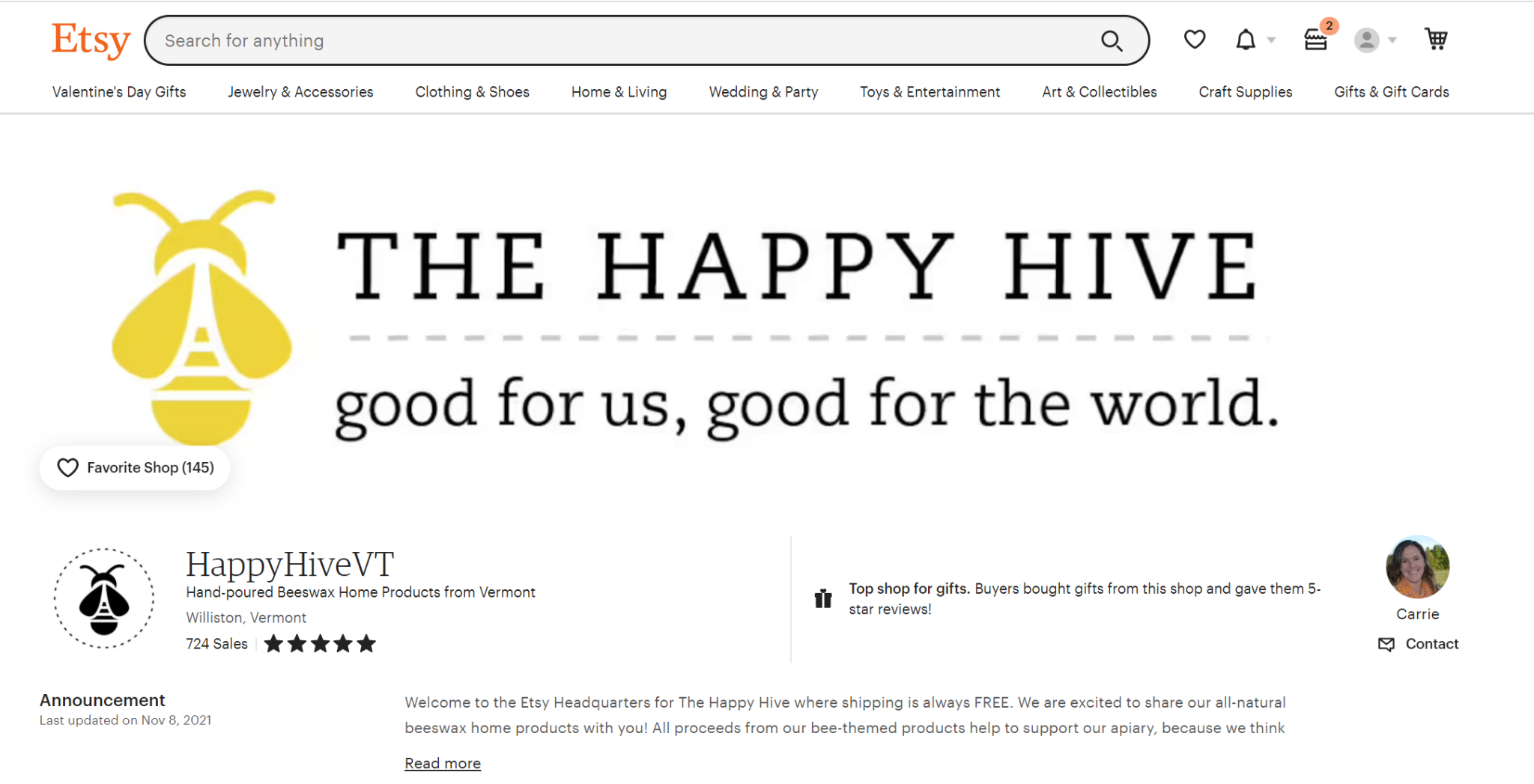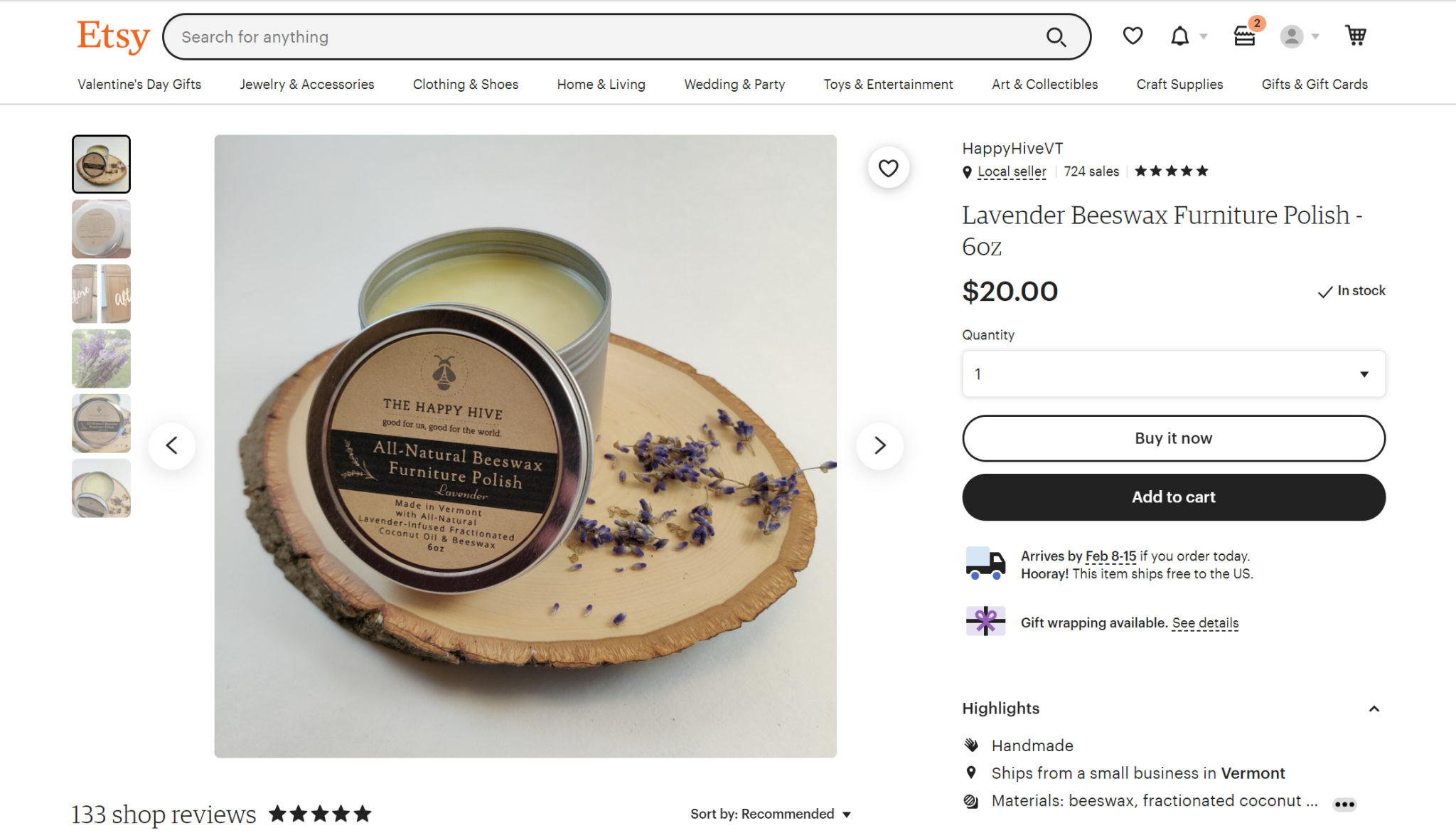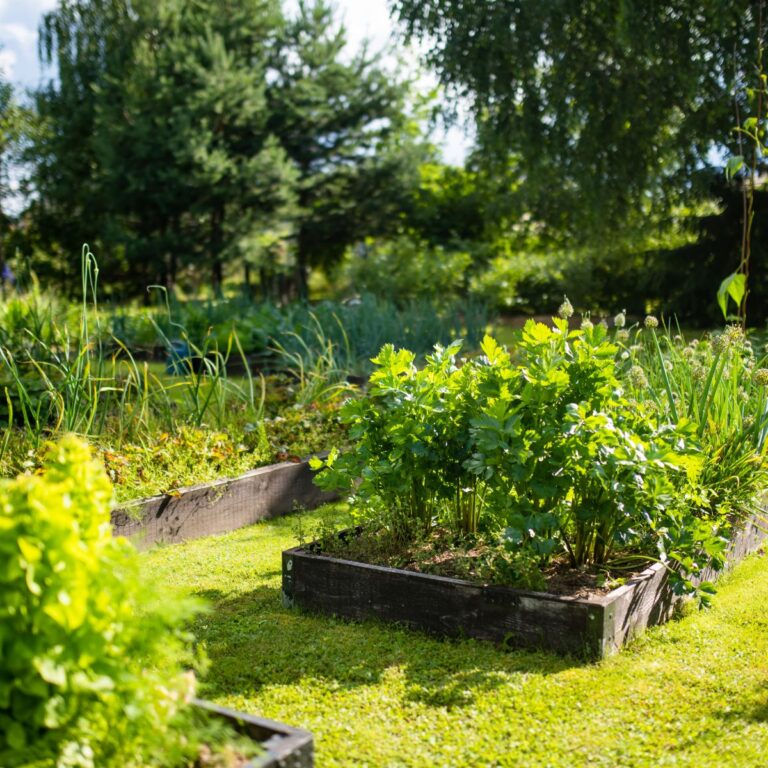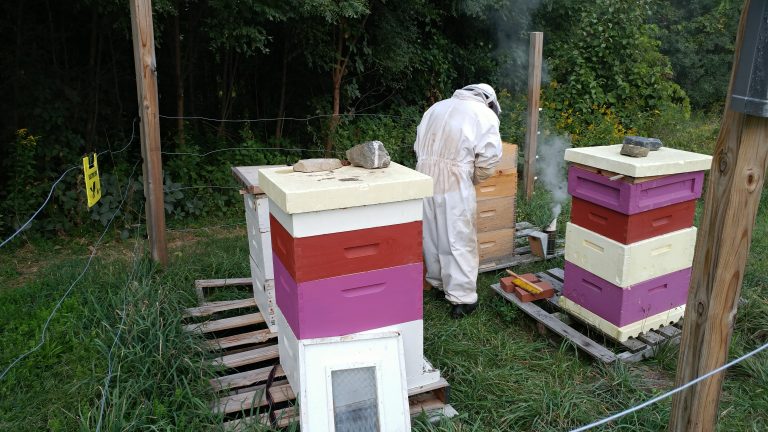This post may contain affiliate links.
Are you eager to turn your homemade homestead or farm-inspired creations into a thriving online business? If so, Etsy is the perfect platform to showcase your unique products to a global audience.
With its user-friendly interface and established marketplace, Etsy allows artisans, crafters, homesteaders, and small business owners to sell their handmade and homegrown goods.
In this detailed guide, we’ll go deep into the ins and outs of selling on Etsy, providing valuable insights and practical tips at every step.

Why Sell on Etsy
With several years of running our Etsy shop specializing in homemade beeswax products, we’ve gained valuable insights into online business. Our customer base grows, and our product range expands over time. From trying different marketing strategies to introducing new items, we’ve learned what it takes to succeed on Etsy.
Drawing from our experience in homesteading and DIY projects, we’ve explored various ways to turn our crafting hobbies into profitable ventures – From making self-care products to handcrafting wooden items.
Selling on Etsy isn’t just about listing your products; it’s about connecting with your audience and mastering e-commerce. While Etsy is often associated with artisans and jewelry makers, there’s also a growing market for homemade and vintage items. This presents an opportunity for homestead entrepreneurs to showcase their products.
Here are some of the most common reasons you might choose Etsy:
- Etsy is a great platform for small business owners, especially when you are first getting started. Setting up a shop is easy; millions of potential customers seek unique, handmade products.
- Etsy offers sellers a great way to reach your audience. Millions of people visit Etsy daily for unique homemade and vintage products; if you are just getting started, you can get your product in front of them without attracting them to your website or shopfront.
- Etsy is a very user-friendly platform. It’s easy to navigate, and shoppers can easily find what they want. This makes it a great choice for sellers who want to sell handmade products but don’t want to spend much time on the technical aspects.
- Etsy offers sellers several tools to help you manage your shop and track how well your products sell. This takes some of the guesswork out of running an online business.
- Etsy also typically collects sales tax on behalf of the sellers, making it an easy way to handle your tax obligations.
- Etsy is a great platform for buyers to purchase directly from makers, eliminating the “middleman” of a store or sales venue. While they collect a percentage of your sales price, it is often less than other selling sites.

How to Create Your Etsy Shop
Now that you have a clear idea of what you want to sell and how you’ll price it, let’s dive into setting up your shop on Etsy. Fortunately, the process for selling homemade items on Etsy is very simple. Here’s a step-by-step guide to get you started.
- First, create an account on Etsy. This will be under your name and email address, preferably an email address connected to your shop or product.
- Then, create your shop. You’ll need a name for your shop that isn’t already taken. When choosing a name, pick something that accurately represents your products and is easy for customers to remember. This name will be your brand, so carefully consider it before committing. It helps if you have a logo and some images for your shop’s banner and homepage. If you plan to sell a diversity of homestead products, you could use the name of your homestead or farm – make sure it conveys a “brand” or image that says something about what you will sell.

- Next, set up your payment information. You’ll need to provide Etsy with your bank account information so you can be paid for the items you sell. Consider setting up a separate bank account for your business if you already have one. This will help with record-keeping.
- Fill in your shop info. Ensure that your Etsy shop bio reflects your brand story authentically. Share details about how you started your Etsy journey, the time it takes to craft each product, and your shipping process. If applicable, decide on your return policy and outline the procedure clearly. Integrate elements of your homesteading lifestyle into your brand narrative to connect with customers. If your location or homestead influences your products, include descriptive text and photos to effectively convey your unique brand story.
- Set up your shop preferences. Customize your shop preferences to align with your business needs. Determine your accepted payment methods, such as PayPal or credit cards. Specify shipping costs and delivery times for different items. Additionally, indicate whether certain products are exclusively available for local pickup or delivery.

How to Choose the Right Products for Your Etsy Shop
When identifying the right products to sell, you must consider factors such as market demand, your skills and interests, and the unique value proposition of your offerings are important when figuring out the right products to sell. Here are a few things to keep in mind when choosing where to start:
Start with what you know.
When you’re starting, it can be helpful to start by selling products related to what you already make or grow on your homestead. This will help you build your brand and get started on Etsy with some momentum.
If you are a homesteader, you are probably already making many things at home. Whether you are a sewer, a knitter, a woodworker, or a crafter, you likely have something others would love to use.
What are you good at? What do you love making? What could you see yourself making over and over again? What are you uniquely qualified to make? These are the things that are great candidates for Etsy.
From artisanal soaps and hand-spun yarn to intricately crafted candles and delicious homemade preserves, Etsy welcomes a diverse range of products that cater to niche markets and discerning buyers.
Research what’s selling.
Do some research to see what types of products are selling well on Etsy. This can give you an idea of what to focus on in your shop. To do quick and easy research, type a term in the search bar like “garden tools” or “soap,” find shops doing well with those products, and see their best-sellers. Can you sell something similar with your unique twist?
Be aware that some products may be oversaturated; in the homesteading world, soap and candles are examples of things many people are selling, as are knitted goods. If you will enter into one of these product areas, see the next bullet point!
Be unique.
When choosing products to sell, think about how you can offer something unique to your shop. This doesn’t mean you have to come up with a brand-new idea; it just means making sure the products in your shop differ from what other sellers offer. Are your ingredients home-grown? Is your product organic or all-natural? What sets you apart?
Start small.
It’s important not to bite off more than you can chew when starting on Etsy. When you’re first getting started, it might be a good idea to start with just a few items in your shop.
This will help you organize and ensure that each product is high quality before you add it to your shop. It will also ensure you can meet customer demand without getting overwhelmed or running out of your product.
Be consistent.
When first starting, it’s best to sell related products that work well together in your shop. This can help ensure your brand is cohesive from the beginning, which will help build a loyal customer base.
Design great packaging.
Your items will likely have to be packaged in some way. While being creative with your label and brand is key, keep your packaging simple to keep costs and processing time in check.
We love recyclable packaging and try to avoid plastic (which seems to please many customers). Click here for helpful hints on designing labels for your homemade products.
Read Etsy’s selling guidelines to ensure your item is allowed. This list of prohibited items is a good place to start. While food can be sold on Etsy, your business must follow local food sales and production guidelines, so research!
How to Set Prices on Etsy
When selling homemade items on Etsy, you must provide a price for your product. This can be tricky, as you don’t want to price yourself out of the market – but you also don’t want to sell your products too cheap. Here are some tips:
Compare Pricing
When determining your prices on Etsy, it’s essential to conduct a comparative analysis. Start by researching the average price for similar products on the platform. See what the average price is for a similar product.
While staying within this range is beneficial, remember that your product’s uniqueness may warrant a higher price.
Follow Traditional Guidelines
Follow traditional guidelines for pricing homemade items by calculating the cost of ingredients or materials and adding labor costs. Typically, you’d multiply this total by two for wholesale and three for market prices. Ensure that your pricing aligns with similar items on Etsy to remain competitive.
Use Etsy’s Pricing Tools
Etsy offers sellers a few different tools to help them set prices. The first is called “Shop Pricing”. This tool allows you to set your profit margin. It will then calculate how much you need to charge to make that amount of money.
This can be helpful if you have a strict budget or are trying to keep prices low without sacrificing the quality of your product.
The second tool is called “Etsy’s Calculator”. This one calculates how much it will cost you to create your item, how much it will cost to ship it, how much you want to make in terms of profit, and how much Etsy charges for listing fees. It then calculates how much you need to charge for all these expenses plus the profit margin amount you specified earlier.
Offer Free Shipping.
Consider offering free shipping to attract customers, as Etsy tends to promote shops with this feature. However, factor in the shipping costs and delivery times when setting your prices to ensure you can cover these expenses within your product’s price.
Tips on How to Add Listings on Your Etsy Shop
Selling homemade items on Etsy is all about conveying their value and their story when you create a listing. Here are a few tips when listing your products:
- Title your product well. When someone is searching for a specific item on Etsy, the title is one of the things they will use to determine if it’s the right product. Ensure your title is descriptive and keyword-rich so that it will appear in search results.
- Add quality photos. Photos are a key part of any Etsy listing, and they are especially important when selling handmade products. Take high-quality photos from different angles, and use a clear and consistent naming convention for your files. Check out our article on building a light box for product photography – it can take your images up a notch and help your product get noticed!
- Write a great description. The description is your opportunity to sell your product and explain what makes it special. Make sure to include all the details someone would want to know, like how the item is made, what materials are used, sizing information, and care instructions.
- Use keywords in your listing. As with the title, you want to use keywords throughout your listing so that it will show up in search results. Etsy provides a list of recommended keywords for each category, and you can also find helpful tips online.
- Don’t forget shipping. You will need to figure out how much it will cost to ship your product to your customers and how long it will take. You’ll need this information to create a shipping profile (this can be done while you create a listing). Remember that Etsy promotes shops that offer free shipping or shipping on bundles. Work this into your pricing estimate and see if you can realistically cover shipping in your sales price.
- Promote your shop! We’ll talk about marketing and promoting your Etsy shop in an article to follow. Still, you can begin by announcing the shop on your social media accounts and letting friends and family know about it. If folks have been asking about your products, now is a great time to let them know they can purchase them online!
Other posts you might like:
By following these steps, you can launch your small business on Etsy and get ready to celebrate your first sale! Remember that making your first sale can take a while, especially in a competitive niche.
You may need to offer sales and incentives or invite your close friends and family to make a few purchases to get your shop rolling.
Be patient, and don’t lose hope. Once great reviews start pouring in, your shop will gain momentum! Selling homemade products on Etsy is both rewarding and fun.
Carrie Williams Howe is an educational leader by day and an aspiring homesteader by night and weekend. She lives on a small homestead in Vermont with her husband, two children, and a rambunctious border collie. She blogs about her family's homestead life at The Happy Hive.





